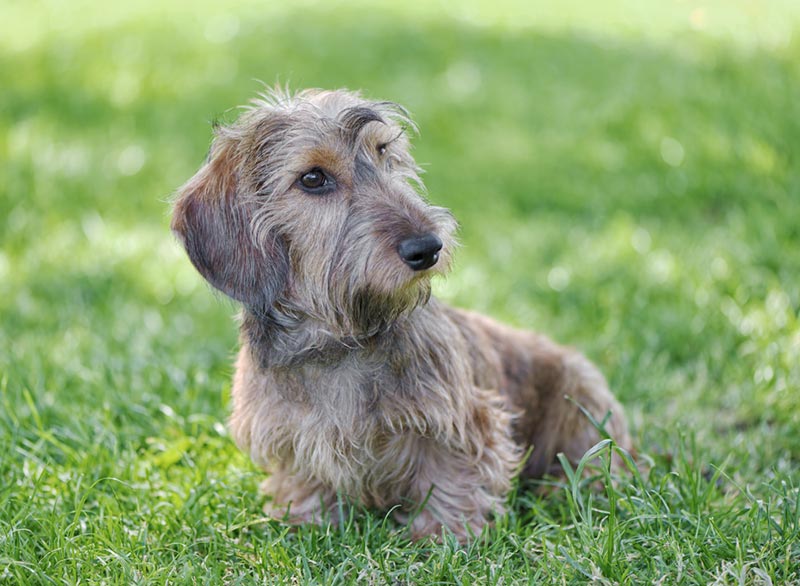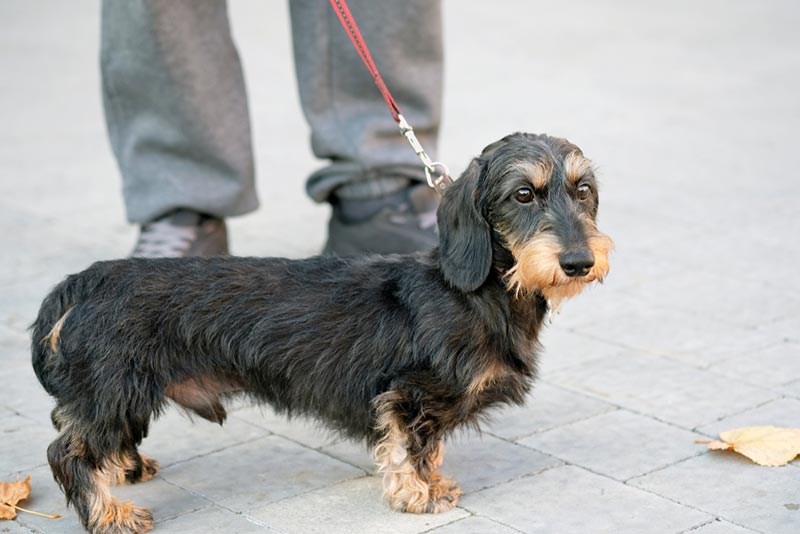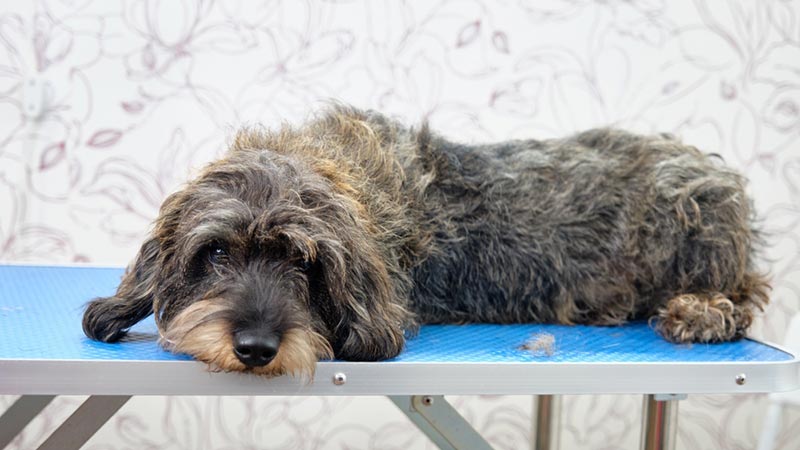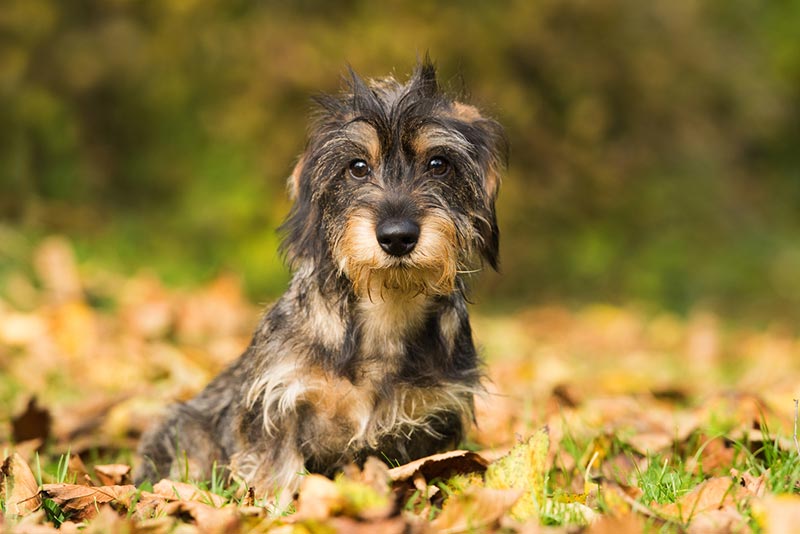Like all breeds of Dachshund, the Silky Wire-Haired Dachshund has short legs and a long back, but this is a very rare breed that is actually a cross between a wire-haired and a long-haired, with the latter being where it gets the “silky” element of its name.
Breed Overview
Height:
14 – 19 inches (standard); 12-15 inches (miniature)
Weight:
16 – 32 pounds (standard); under 11 pounds (miniature)
Colors:
Solid red, black, and tan, red and tan, merle
Suitable for:
Families with older children
Temperament:
Devoted, playful, curious
The coat is long and appears silky, but the individual strands of hair are wiry. It is considered lower maintenance than the other breeds because of this combination of hair types, but it is very rare.
Dachshund Characteristics
The Earliest Records of Silky Wire-Haired Dachshunds
Dachshunds have a long history, dating back to 15th-century Germany. They were bred for hunting small game. Their short legs enabled them to get into badger setts and foxholes while their loud bark alerted hunters to their whereabouts when they caught their quarry.
The breed primarily includes the short-haired, which is the most common, as well as the long-haired, sometimes also referred to as the Silky Dachshund, and Wire-haired. The Silky Wire-Haired Dachshund is a cross between a wire-haired and a long-haired Dachshund, effectively combining the features of the two. It is very rare when compared to the three main types, but it is popular with some owners because its coat requires less care than the long-haired one but has the same silky appearance.

How Silky Wire-Haired Dachshunds Gained Popularity
Dachshunds were originally bred as hunting dogs, and they were especially effective going to ground when hunting for badgers, foxes, and other small game that used burrows and holes. As hunters, Dachshunds are intelligent and lively, and this soon saw them being adopted into homes and families, as well as being used in the fields.
Although some are still used as working dogs today, they are more likely to be seen as family pets. Dachshunds are popular around the world, although different countries do tend to have different preferences. For example, the Wire-haired Dachshund is the most popular in Germany but the least popular in the US.
Formal Recognition of Silky Wire-Haired Dachshunds
As a cross between the Wire-haired and the Long-haired Dachshund, the Silky Wire-Haired Dachshund does not meet a lot of kennel club standards. In most cases, kennel clubs give standards for the wire-haired variety, which must have short and wiry hair and the long-haired variant.
This variant is most likely to fall under the standards of the long-haired breed, but most kennel clubs demand that the coat be straight or only slightly waved, so some examples of the breed might not qualify in this regard. However, just because the Silky Wire-Haired is not recognized as the standard doesn’t mean it isn’t popular with some breeders and owners.

Top 4 Unique Facts About Silky Wire-Haired Dachshunds
1. They Come in Three Sizes
Although only two are officially recognized by a lot of kennel clubs and authorities, there are three legitimate sizes of Dachshund. Standard and miniature sizes are recognized around the world, but there is a smaller breed which is called “rabbit-size” in German, but you might also hear them referred to as teacup or toy size.
2. Silky Wire-Haired Dachshunds Are Low-Shedding Dogs
Specifically, the Silky Wire-haired Dachshund is a low-shedding dog. It has a long coat that looks shiny and soft, but this coat has the traits of the wire-haired, which means that fewer dead hairs fall out.
This can be good news for allergy sufferers. Although the dogs do still produce the protein that causes allergic reactionsb because the dog sheds less, the hair is less likely to get on furniture and irritate allergy sufferers.

3. They Were Once Called Badger Dogs
“Dachshund” literally translates to “badger dog.” And while the breed doesn’t go by this translation now, it was rebranded as such during World War I. The breed was popular in Germany at the time, and its popularity fell outside the country because of its association with Germany’s leader, Kaiser Willhelm II, who loved the Dachshund so much that he had several of them.
4. Silky Wire-Haired Dachshunds Can Live a Very Long Time
Since the Guinness World Records started, there have been 23 dogs to be given the title of the world’s oldest dog. Two of those dogs have been Dachshunds and one more was a Dachshund cross. The breed is said to have a life expectancy between 12–15 years, but they can occasionally live to 20 years or older.
Does a Silky Wire-Haired Dachshund Make a Good Pet?
The Dachshund has become a very popular breed of dog around the world and is especially popular in the US as well as its homeland, Germany. It is intelligent and generally enjoys pleasing its owner, which means that it can be easy to train in the right hands. It is also energetic and lively and is considered a fun breed, especially for families that are willing to put some time into exercise and playtime.
However, owners do need to be careful with their long backs. The Dachshund should be discouraged from going up and down stairs and owners might need to erect canine stairs up to furniture and up to the main doors of the house to provide easy access for this uniquely featured canine.
The Silky Wire-Haired Dachshund, specifically, is somewhat easier to keep than others because it is low shedding, which means less vacuuming and cleaning up after the pup.
Conclusion
The Silky Wire-Haired Dachshund is a cross between the Wire-haired and the Long-haired Dachshund. It is very rare and may not be officially recognized by kennel clubs, but its low shedding means that it can be a popular choice with owners who suffer from dog allergies or who don’t want the clean-up that comes with heavy shedders.
The dog originates from Germany, where it was bred as a hunting dog, but it has become popular globally as a loyal and loving family pet.
Featured Image Credit: Dora Zett, Shutterstock


